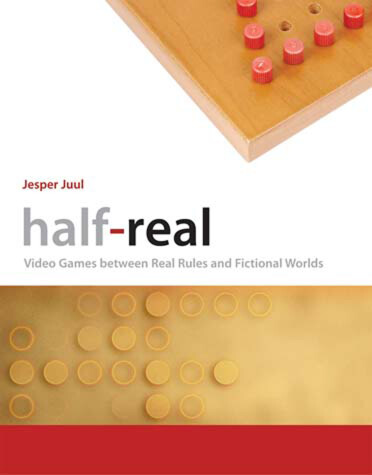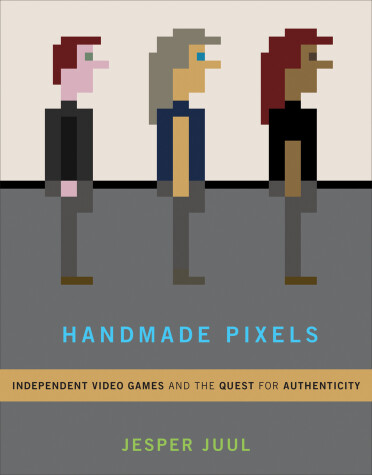The MIT Press
3 total works
An in-depth analysis of game development and rules and fiction in video games—with concrete examples, including The Legend of Zelda, Grand Theft Auto, and more
A video game is half-real: we play by real rules while imagining a fictional world. We win or lose the game in the real world, but we slay a dragon (for example) only in the world of the game. In this thought-provoking study, Jesper Juul examines the constantly evolving tension between rules and fiction in video games. Discussing games from Pong to The Legend of Zelda, from chess to Grand Theft Auto, he shows how video games are both a departure from and a development of traditional non-electronic games. The book combines perspectives from such fields as literary and film theory, computer science, psychology, economic game theory, and game studies, to outline a theory of what video games are, how they work with the player, how they have developed historically, and why they are fun to play.
Locating video games in a history of games that goes back to Ancient Egypt, Juul argues that there is a basic affinity between games and computers. Just as the printing press and the cinema have promoted and enabled new kinds of storytelling, computers work as enablers of games, letting us play old games in new ways and allowing for new kinds of games that would not have been possible before computers. Juul presents a classic game model, which describes the traditional construction of games and points to possible future developments. He examines how rules provide challenges, learning, and enjoyment for players, and how a game cues the player into imagining its fictional world. Juul’s lively style and eclectic deployment of sources will make Half-Real of interest to media, literature, and game scholars as well as to game professionals and gamers.
A video game is half-real: we play by real rules while imagining a fictional world. We win or lose the game in the real world, but we slay a dragon (for example) only in the world of the game. In this thought-provoking study, Jesper Juul examines the constantly evolving tension between rules and fiction in video games. Discussing games from Pong to The Legend of Zelda, from chess to Grand Theft Auto, he shows how video games are both a departure from and a development of traditional non-electronic games. The book combines perspectives from such fields as literary and film theory, computer science, psychology, economic game theory, and game studies, to outline a theory of what video games are, how they work with the player, how they have developed historically, and why they are fun to play.
Locating video games in a history of games that goes back to Ancient Egypt, Juul argues that there is a basic affinity between games and computers. Just as the printing press and the cinema have promoted and enabled new kinds of storytelling, computers work as enablers of games, letting us play old games in new ways and allowing for new kinds of games that would not have been possible before computers. Juul presents a classic game model, which describes the traditional construction of games and points to possible future developments. He examines how rules provide challenges, learning, and enjoyment for players, and how a game cues the player into imagining its fictional world. Juul’s lively style and eclectic deployment of sources will make Half-Real of interest to media, literature, and game scholars as well as to game professionals and gamers.
We used to think that video games were mostly for young men, but with the success of the Nintendo Wii, and the proliferation of games in browsers, cell phone games, and social games video games changed changed fundamentally in the years from 2000 to 2010. These new casual games are now played by men and women, young and old. Players need not possess an intimate knowledge of video game history or devote weeks or months to play. At the same time, many players of casual games show a dedication and skill that is anything but casual. In A Casual Revolution, Jesper Juul describes this as a reinvention of video games, and of our image of video game players, and explores what this tells us about the players, the games, and their interaction. With this reinvention of video games, the game industry reconnects with a general audience. Many of today's casual game players once enjoyed Pac-Man, Tetris, and other early games, only to drop out when video games became more time-consuming and complex.
Juul shows that it is only by understanding what a game requires of players, what players bring to a game, how the game industry works, and how video games have developed historically that we can understand what makes video games fun and why we choose to play (or not to play) them.
Juul shows that it is only by understanding what a game requires of players, what players bring to a game, how the game industry works, and how video games have developed historically that we can understand what makes video games fun and why we choose to play (or not to play) them.
An investigation of independent video games—creative, personal, strange, and experimental—and their claims to handcrafted authenticity in a purely digital medium.
Video games are often dismissed as mere entertainment products created by faceless corporations. The last twenty years, however, have seen the rise of independent, or “indie,” video games: a wave of small, cheaply developed, experimental, and personal video games that react against mainstream video game development and culture. In Handmade Pixels, Jesper Juul examine the paradoxical claims of developers, players, and festivals that portray independent games as unique and hand-crafted objects in a globally distributed digital medium.
Juul explains that independent video games are presented not as mass market products, but as cultural works created by people, and are promoted as authentic alternatives to mainstream games. Writing as a game player, scholar, developer, and educator, Juul tells the story of how independent games—creative, personal, strange, and experimental—became a historical movement that borrowed the term “independent” from film and music while finding its own kind of independence.
Juul describes how the visual style of independent games signals their authenticity—often by referring to older video games or analog visual styles. He shows how developers use strategies for creating games with financial, aesthetic, and cultural independence; discusses the aesthetic innovations of “walking simulator” games; and explains the controversies over what is and what isn't a game. Juul offers examples from independent games ranging from Dys4ia to Firewatch; the text is richly illustrated with many color images.
Video games are often dismissed as mere entertainment products created by faceless corporations. The last twenty years, however, have seen the rise of independent, or “indie,” video games: a wave of small, cheaply developed, experimental, and personal video games that react against mainstream video game development and culture. In Handmade Pixels, Jesper Juul examine the paradoxical claims of developers, players, and festivals that portray independent games as unique and hand-crafted objects in a globally distributed digital medium.
Juul explains that independent video games are presented not as mass market products, but as cultural works created by people, and are promoted as authentic alternatives to mainstream games. Writing as a game player, scholar, developer, and educator, Juul tells the story of how independent games—creative, personal, strange, and experimental—became a historical movement that borrowed the term “independent” from film and music while finding its own kind of independence.
Juul describes how the visual style of independent games signals their authenticity—often by referring to older video games or analog visual styles. He shows how developers use strategies for creating games with financial, aesthetic, and cultural independence; discusses the aesthetic innovations of “walking simulator” games; and explains the controversies over what is and what isn't a game. Juul offers examples from independent games ranging from Dys4ia to Firewatch; the text is richly illustrated with many color images.


